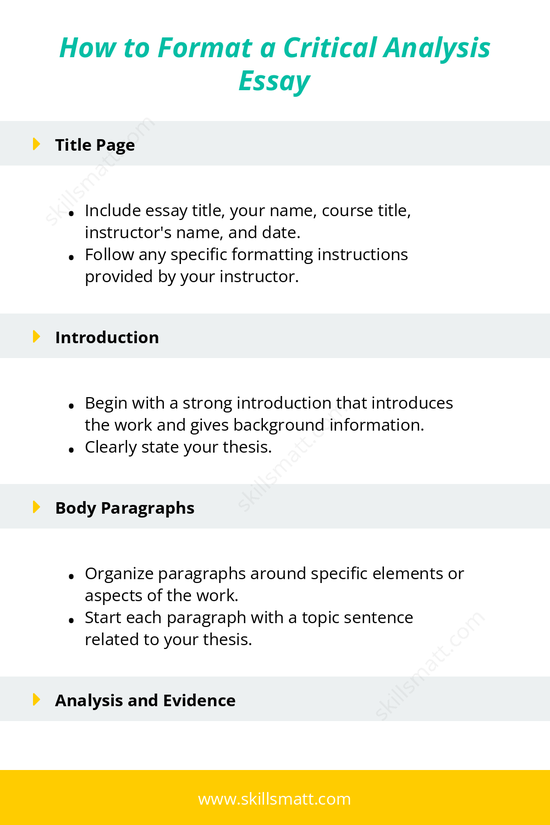How to Format a Critical Analysis Essay
1. Title Page
- Include essay title, your name, course title, instructor's name, and date: Make sure all necessary details are included in the title page. This information should be clear and formatted according to your instructor’s preferences.
- Follow any specific formatting instructions provided by your instructor: Always check for any special guidelines regarding spacing, font, or page setup.
2. Introduction
- Begin with a strong introduction that introduces the work and gives background information: The introduction should set the context for the analysis and include relevant details about the work being discussed, such as the title, author, or creator, and the work's significance.
- Clearly state your thesis: Present your main argument or perspective that will guide the rest of the essay. The thesis should indicate what your analysis will explore and the conclusions you have drawn.
3. Body Paragraphs
- Organize paragraphs around specific elements or aspects of the work: Each paragraph should focus on one key element, such as themes, characters, symbolism, or narrative techniques, making the analysis structured and easy to follow.
- Start each paragraph with a topic sentence related to your thesis: Each body paragraph should begin with a statement that clearly ties the paragraph’s content to your overall argument, ensuring coherence throughout your essay.
4. Analysis and Evidence
- Analyze chosen elements of the work thoroughly: Dive into the specifics of the elements you are discussing. Explain how they contribute to the overall meaning of the work, and interpret them in relation to your thesis.
- Support your analysis with quotes, examples, or specific scenes from the work: Incorporate textual or visual evidence to reinforce your points. This makes your analysis more credible and compelling.
5. Evaluation
- Evaluate the strengths and weaknesses of the work: Discuss what the work does well and areas where it could improve. This evaluation should be based on your analysis and supported by evidence.
- Discuss what works well and areas for improvement with supporting evidence: Make sure your evaluations are balanced and grounded in specific examples from the work itself.
6. Conclusion
- Summarize key points of your analysis: Recap the main elements of your analysis, highlighting the significance of your findings.
- Restate your thesis and highlight the significance of your findings: Conclude by reiterating your thesis in light of the analysis and emphasizing the value of your conclusions.
7. References or Works Cited
- Include a list of all cited sources: Ensure that you cite all the works referenced in your essay to give credit to the original creators and to maintain academic integrity.
- Follow the specified citation style (APA, MLA, Chicago, etc.): Use the appropriate citation style as per your instructor’s requirements, and make sure all citations are formatted correctly.
8. Formatting Style
- Use a standard 12-point font (e.g., Times New Roman, Arial): A readable font is essential for clarity. Times New Roman or Arial are commonly used, but always follow your instructor’s instructions.
- Double-space the essay, set 1-inch margins on all sides, and align text to the left: These are standard formatting practices. Ensure the entire essay is properly formatted to meet academic requirements.
9. Page Numbers
- Number pages consecutively, starting from the title page: Ensure that all pages are numbered so that they can be easily referenced. Starting from the title page is standard.
- Place page numbers in the header or footer: Follow the appropriate style guide for page number placement.
10. Additional Instructions
- Follow any other formatting guidelines specified by your instructor: Always double-check the specific formatting instructions given to you by your instructor, including details on headings, subheadings, or special formatting rules.
- Check for specific requirements for headers, footers, or other elements: Some instructors may require headers or specific footer information. Be sure to review and implement these instructions precisely.


